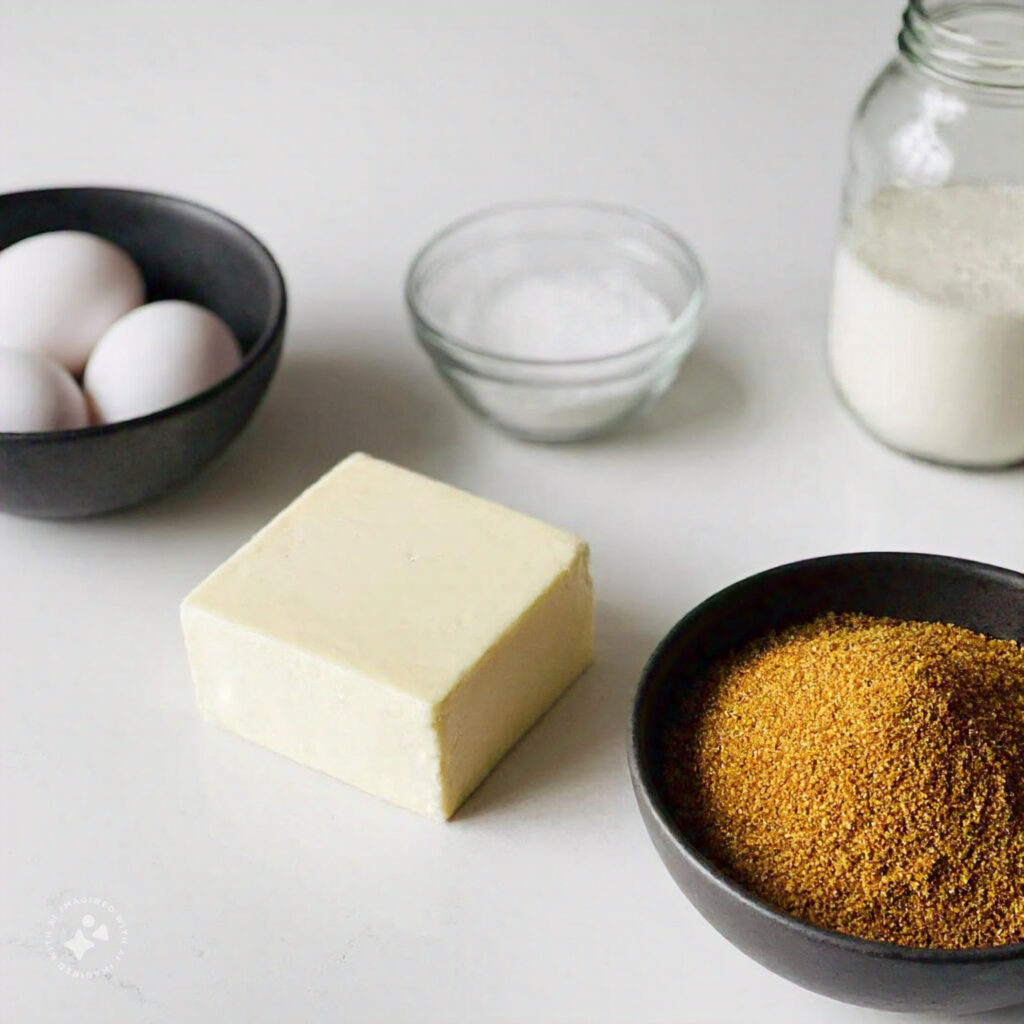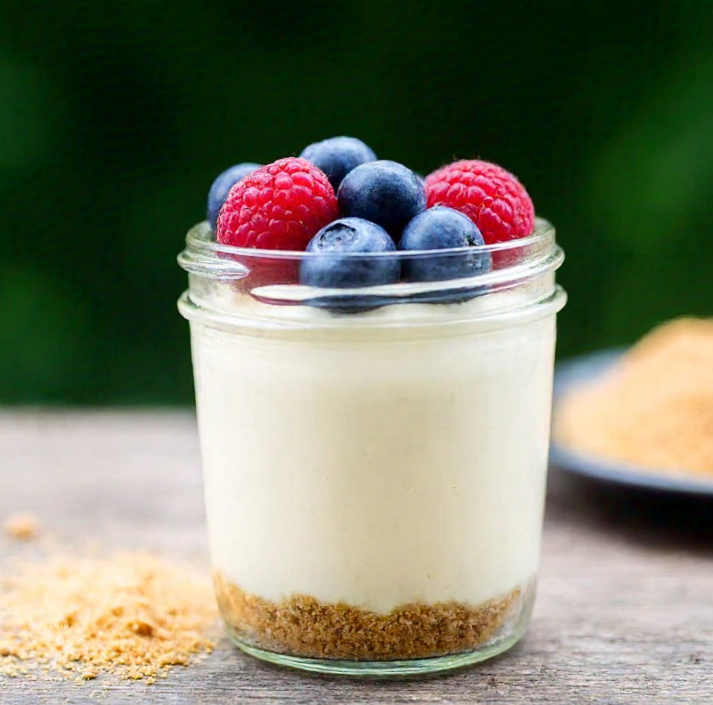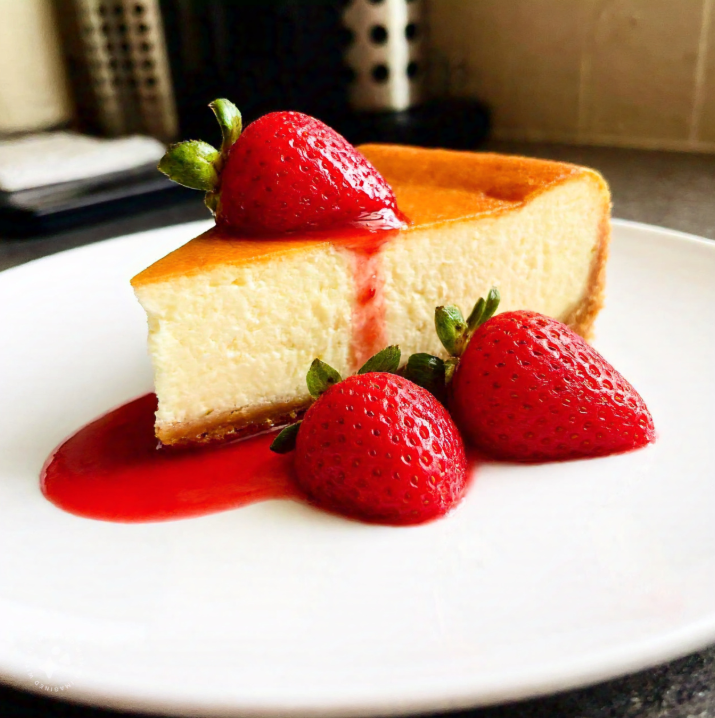Cheesecake—just the thought of it can make your mouth water. That creamy, decadent texture paired with a buttery crust is irresistible. But achieving that perfect firmness and consistency is not always as easy as eating it. So, what is the thickening agent in cheesecake? That’s the big question here!
In this guide, we’ll uncover the secret behind that smooth, luscious cheesecake texture. Whether you’re whipping up a no-bake version or going for the classic baked style, understanding thickening agents is key. From gelatin to eggs and even vegan substitutes, we’ll walk you through the best ingredients and techniques to make your cheesecake flawless.
Table of Contents
Ready to become a cheesecake master? Let’s dive in!
Understanding Cheesecake: A Delicious Overview

Cheesecake has been a beloved dessert for centuries. It originated in ancient Greece, where it was often made as a simple combination of cheese, flour, and honey. Over time, the recipe evolved, and today, it’s a culinary masterpiece enjoyed worldwide.
At its core, cheesecake is made of a few key components:
- Cream cheese or other soft cheese for the creamy base.
- Sugar for sweetness.
- Eggs or thickening agents to bind the ingredients together.
- A crust made from crushed biscuits or graham crackers for contrast.
But what makes it so special is its unique, velvety texture—neither a cake nor a pudding, but something wonderfully in between. The magic happens thanks to the thickening agents, which ensure the cheesecake sets perfectly without falling apart or being too runny.
There are two main types of cheesecakes: baked and no-bake. Each requires specific thickening agents to achieve the ideal consistency, and that’s where things get interesting.
Importance of Thickening Agents in Cheesecake
The thickening agent in cheesecake is not just a random addition; it’s the backbone of the dessert. Without the right ingredient, your cheesecake can turn into a soggy, runny mess—definitely not what you’re aiming for.
Thickening agents serve several purposes:
- Structure and Stability: They give the cheesecake its firmness so that it holds its shape.
- Texture Enhancement: A good thickener creates a creamy, smooth consistency that melts in your mouth.
- Moisture Control: Cheesecake has a lot of moisture from cream cheese and eggs, and thickening agents help manage this.
For baked cheesecakes, thickening agents like eggs are essential because they bind the ingredients when heated. On the other hand, no-bake cheesecakes often rely on gelatin or other stabilizers to set properly without the need for heat.
The wrong thickener or incorrect usage can ruin your hard work. Imagine pulling your cheesecake out of the fridge, only to find it’s still jiggly and soft. That’s heartbreaking!
So, understanding how these agents work—and when to use them—is a game-changer for your baking skills.
What is the Thickening Agent in Cheesecake?
Now for the big reveal: what is the thickening agent in cheesecake? Well, it depends on the type of cheesecake you’re making!
For Baked Cheesecakes:
- Eggs are the primary thickening agent. When eggs are baked, they coagulate (solidify) and bind the cheesecake ingredients together. This creates a dense, firm texture with a slight wobble—just perfect.
For No-Bake Cheesecakes:
- Gelatin takes the spotlight here. Gelatin is a natural thickening agent that sets as it cools, giving no-bake cheesecakes a firm but creamy consistency. It’s often dissolved in warm water or milk before being added to the filling.
However, there’s more to the story. Other ingredients like cornstarch, cream cheese itself, or even alternative thickeners such as agar-agar can also play a role, depending on your recipe.
Understanding the right thickening agent for the type of cheesecake you’re making is the first step toward baking success.
Types of Cheesecakes and Their Texture Requirements
Before we get into the nitty-gritty of specific thickening agents, let’s look at the two main types of cheesecakes and how their texture requirements differ.
Baked Cheesecake: How Thickening Agents Play a Role
Baked cheesecake is the more traditional version, often referred to as “New York-style cheesecake.” It’s dense, rich, and indulgent, thanks to its reliance on eggs as the thickening agent in cheesecake.
Here’s how eggs work:
- When baked, the proteins in eggs firm up and create structure.
- Eggs act as natural emulsifiers, blending the cream cheese, sugar, and other ingredients seamlessly.
- Overbaking, however, can lead to cracks on the surface, as the eggs dry out and lose moisture.
No-Bake Cheesecake: Why Thickening Agents are Essential
No-bake cheesecake, on the other hand, is all about convenience. It’s lighter and softer, with a mousse-like texture. Since it doesn’t go in the oven, it relies on stabilizers like gelatin to set properly in the fridge.
Here’s why gelatin works so well:
- Gelatin firms up as it cools, creating a stable yet soft texture.
- It allows the cheesecake to hold its shape without the need for heat.
No-bake cheesecakes are perfect for summer, as they require minimal effort and zero baking time. However, they do need to be chilled for several hours to achieve the perfect set.
Common Thickening Agents Used in Cheesecake
Now that we’ve touched on the types of cheesecakes and their texture requirements, let’s take a closer look at the thickening agents themselves. The choice of thickener can drastically impact the taste, texture, and even the ease of preparation for your cheesecake. Here’s a breakdown of the most common options and their roles.
Cream Cheese: The Primary Ingredient
First things first, cream cheese is the hero of any cheesecake. While it’s not exactly a “thickening agent” in the traditional sense, its rich, dense texture sets the foundation for the dessert.
- Why it works: Cream cheese has a naturally thick and creamy consistency, which adds body to the filling.
- Limitations: It needs help from other thickeners to achieve the desired firmness, especially in no-bake recipes.
Pro tip: Use full-fat cream cheese for the creamiest results. Reduced-fat versions can be watery and affect the texture.
Gelatin: A Key Thickening Agent for No-Bake Cheesecakes
Gelatin is the MVP of no-bake cheesecakes. This translucent, flavorless thickening agent is derived from animal collagen and works wonders for creating a firm but soft texture.
- How to use it: Dissolve gelatin in warm water or milk before adding it to your cheesecake mixture. Let it cool slightly before incorporating it, to avoid lumps.
- Why it works: Gelatin sets as it cools, stabilizing the filling without the need for heat.
However, gelatin can be tricky for beginners. Adding it too soon while it’s hot can create clumps, and too little gelatin might result in a cheesecake that doesn’t hold its shape.
Cornstarch: An Alternative for Stability
Cornstarch is a pantry staple that works as a thickener in both baked and no-bake cheesecakes. It’s particularly useful if you’re looking for an alternative to eggs or gelatin.
- Why it works: When heated, cornstarch activates and thickens the mixture by absorbing liquid.
- How to use it: Mix cornstarch with a bit of water to create a slurry, then add it to your batter.
Cornstarch is great for recipes where you want a firmer texture without altering the flavor too much.
Eggs: The Natural Binder in Baked Cheesecake
Eggs are the go-to thickening agent for baked cheesecakes, and for good reason! They act as natural binders, giving the dessert its characteristic firmness and structure.
- How they work: When baked, the proteins in eggs coagulate, transforming the liquid filling into a solid, sliceable texture.
- Tips for success: Avoid overbeating the eggs, as this can introduce too much air into the batter, leading to cracks.
Eggs also add richness to the flavor, making them indispensable in classic baked cheesecakes.
Agar-Agar: A Vegan Substitute for Gelatin
For those who prefer a plant-based alternative, agar-agar is a fantastic option. Made from red algae, this vegan thickening agent works similarly to gelatin but is slightly firmer.
- How to use it: Dissolve agar-agar in boiling liquid before adding it to the filling. Unlike gelatin, agar-agar sets at room temperature.
- Why it’s popular: It’s completely vegan, gluten-free, and flavorless, making it a versatile choice for dietary restrictions.
Flour and Tapioca Starch: Secondary Thickeners
In some recipes, you’ll find flour or tapioca starch used as supplementary thickeners. While they’re not as common, they can be helpful in certain scenarios.
- Flour: Often used in baked cheesecakes to add stability. However, it can make the texture slightly denser.
- Tapioca starch: A gluten-free alternative that works well in no-bake recipes for added firmness.
Factors Affecting the Choice of Thickening Agent
Choosing the right thickening agent isn’t just about following a recipe; there are several factors to consider that can impact your results.
Desired Texture and Firmness
Think about the texture you’re aiming for:
- Light and fluffy? No-bake cheesecakes often achieve this with whipped cream and gelatin.
- Dense and creamy? Eggs and cream cheese are your best friends in a baked cheesecake.
The desired firmness also depends on how the cheesecake will be served. A firmer texture is ideal for slices, while a softer one works well for parfaits or cups.
Baking vs. No-Baking: Why It Matters

As we’ve seen, baked and no-bake cheesecakes require different thickening agents:
- Baked cheesecakes depend on heat to activate eggs or flour.
- No-bake cheesecakes rely on cooling to set gelatin or agar-agar.
Understanding this difference ensures you don’t end up with a runny mess when you pull your cheesecake out of the fridge or oven.
Dietary Preferences: Vegan and Gluten-Free Options
Dietary restrictions can play a huge role in your choice of thickening agent:
- For vegans, agar-agar is a perfect substitute for gelatin.
- Gluten-free bakers can use cornstarch or tapioca starch instead of flour.
Always consider your audience’s needs when planning your cheesecake recipe.
How to Use Thickening Agents Properly in Cheesecake
Using thickening agents might seem straightforward, but there are a few tricks to getting it just right.
Tips for Incorporating Gelatin Without Lumps
Gelatin can be finicky, but these tips will help you master it:
- Bloom the gelatin: Always let it soak in cold water for a few minutes before dissolving it in hot liquid.
- Stir continuously: This prevents clumps from forming as the gelatin dissolves.
- Cool before mixing: Adding hot gelatin directly to your cheesecake filling can create uneven textures. Let it cool slightly before incorporating it.
Using Cornstarch to Avoid a Gritty Texture
Cornstarch is a great thickener, but it needs proper handling:
- Mix it with water or milk to create a smooth paste before adding it to the batter.
- Cook the mixture briefly to activate the starch and avoid any gritty texture.
Balancing Eggs for a Perfect Baked Cheesecake
Eggs are powerful, but too much of a good thing can backfire:
- Stick to the recipe’s recommended amount. Adding extra eggs can make the cheesecake overly firm or rubbery.
- Whisk the eggs gently and incorporate them last to minimize air bubbles.
Common Problems Related to Cheesecake Texture
Even with the best intentions and precise measurements, cheesecake mishaps can happen. Understanding the common issues that arise during the cheesecake-making process—and how to fix them—can save your dessert from disaster. Let’s look at some typical texture problems and their culprits.
Why Did My Cheesecake Not Set Properly?
This is one of the most common questions asked by home bakers: why didn’t my cheesecake set? The answer often lies in the thickening agent or its improper use.
Possible Reasons:
- Insufficient thickener: If you didn’t use enough gelatin or eggs, the filling won’t have enough structure.
- Improper activation: Gelatin needs to bloom and dissolve correctly, while eggs require adequate baking to solidify.
- Insufficient chilling time: No-bake cheesecakes often need at least 6–8 hours to set properly in the fridge.
Solution:
- Double-check your recipe measurements for thickening agents.
- Allow adequate time for the cheesecake to set, especially if it’s no-bake.
Why is My Cheesecake Too Runny?
A runny cheesecake is not only disappointing but also challenging to serve. This issue often occurs when the thickening agent fails to activate or there’s too much liquid in the batter.
Possible Reasons:
- Overmixing the batter, especially with cream cheese, can lead to excessive air incorporation, which breaks down the structure.
- Adding too much liquid (like lemon juice, milk, or melted chocolate) without balancing it with a thickener.
Solution:
- Use full-fat cream cheese to ensure a thick base.
- Avoid adding extra liquid ingredients unless specified in the recipe.
- Whisk gently to maintain the batter’s integrity.
How to Fix a Soft or Soggy Cheesecake
Nobody wants a soggy cheesecake! A soft texture can result from improper baking, cooling, or an imbalance in the ingredients.
Possible Reasons:
- Undercooking a baked cheesecake prevents the eggs from setting fully.
- Using low-fat cream cheese or skipping a thickening agent.
- Overloading the batter with mix-ins (like fruit or chocolate chips) can destabilize the structure.
Solution:
- If baked, return your cheesecake to the oven for a gentle heat treatment, covering it with foil to prevent over-browning.
- For no-bake versions, try re-chilling the dessert and adding a stabilizer like whipped cream or extra gelatin.
Solutions to Cheesecake Thickening Issues
It’s one thing to know the problems, but what about fixing them? Let’s explore some practical solutions to save your cheesecake.
Adjusting Ingredients for Proper Firmness
The right ingredient ratios can make or break your cheesecake. Here’s how to balance them:
- Use the recommended amount of thickening agent for your recipe. For example, 1 tablespoon of gelatin for 2 cups of liquid is a good starting point for no-bake recipes.
- Avoid reducing sugar significantly—it helps maintain the texture.
- If using cornstarch or flour, make sure to cook it briefly to activate its thickening properties.
Substituting Thickening Agents for Dietary Needs
For dietary restrictions, there are always substitutions that work just as well:
- Use agar-agar instead of gelatin for vegan cheesecakes. Start with about half the amount of gelatin called for in the recipe, as agar-agar is more potent.
- Replace flour with cornstarch for gluten-free versions.
- Swap eggs with a combination of cornstarch and water in baked recipes for egg-free alternatives.
Simple Techniques for a Perfect Cheesecake Texture
Sometimes, a little technique adjustment can make all the difference:
- Always use room-temperature ingredients. This ensures even mixing and prevents lumps.
- Avoid overbaking. A baked cheesecake is ready when the edges are set, but the center still jiggles slightly.
- Chill your cheesecake overnight for the best set and flavor development.
Expert Tips to Achieve the Perfect Cheesecake
No matter how many cheesecakes you’ve made, there’s always room to improve. These expert tips will help you elevate your cheesecake game to the next level:
- Preheat your oven or prepare your fridge properly. For baked cheesecakes, a consistent oven temperature is crucial. Use a water bath (bain-marie) to prevent cracks.
- Don’t skip the resting period. Letting your cheesecake cool gradually reduces the risk of cracks and helps the texture stabilize.
- Line your pan carefully. A parchment-lined springform pan ensures your cheesecake comes out cleanly, preserving its appearance.
Bonus Tip: Garnish with a purpose. Whether it’s fresh fruit, whipped cream, or a drizzle of caramel, the right topping can enhance both flavor and texture.
Conclusion: Mastering the Thickening Agent in Cheesecake
So, what is the thickening agent in cheesecake? As we’ve explored, it depends on the type of cheesecake you’re making and your desired outcome. Baked cheesecakes rely on eggs for their structure, while no-bake versions depend on gelatin or other stabilizers.
Mastering the art of cheesecake is as much about understanding the ingredients as it is about perfecting your technique. From cream cheese and gelatin to eggs and agar-agar, each thickening agent plays a unique role in achieving that luscious texture we all love.
Now that you know the ins and outs of cheesecake thickening agents, it’s time to put your knowledge to the test. Try different combinations, experiment with textures, and don’t be afraid to make mistakes—it’s all part of becoming a cheesecake pro!
For additional tips on creating no-bake bases, explore this simple no-bake cheesecake recipe, or What is Biltmore Cheesecake?.
Happy baking! 😊

